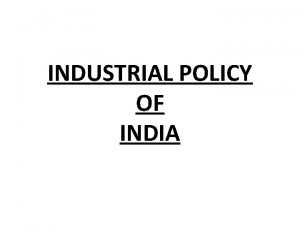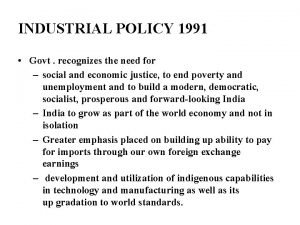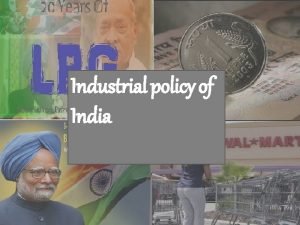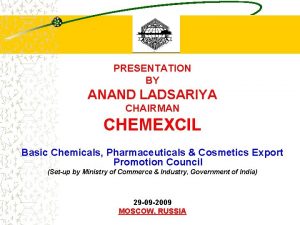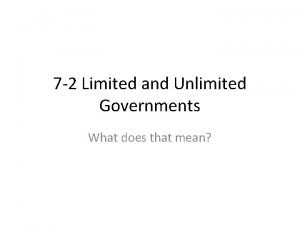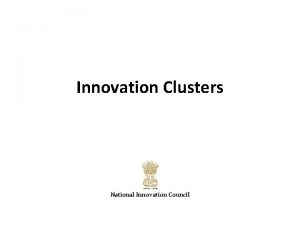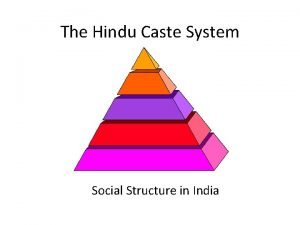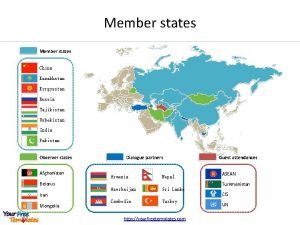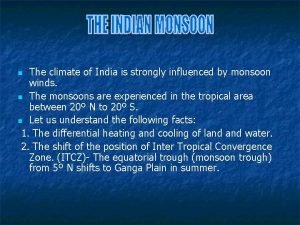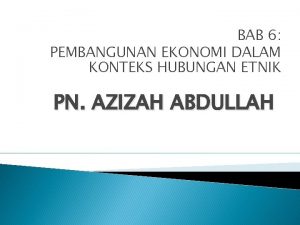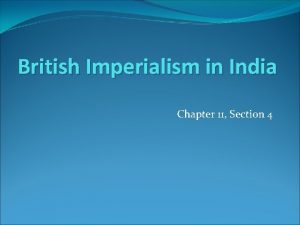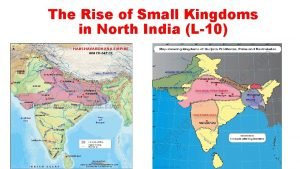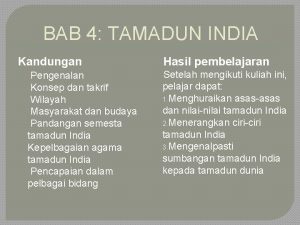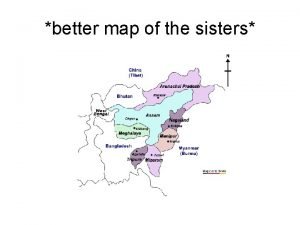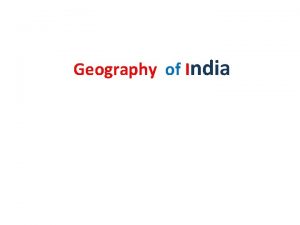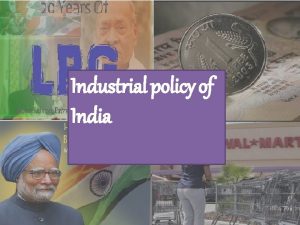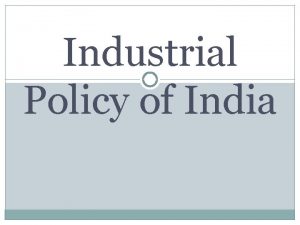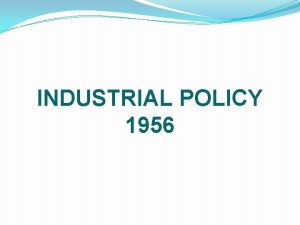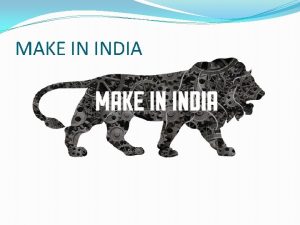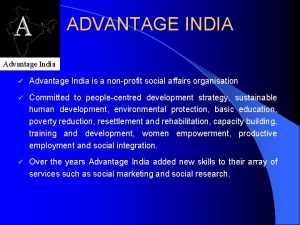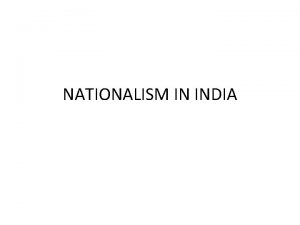INDUSTRIAL POLICY OF INDIA INDUSTRIAL POLICY OF INDIA




































- Slides: 36

INDUSTRIAL POLICY OF INDIA





INDUSTRIAL POLICY OF INDIA • Broadly divided into two categories Ø Controlled era (Untill 1991) Ø Liberalized era ( Post 1991) The pattern and pace of development of the economy are significantly influenced by the Industrial policy of the country

INDUSTRIAL POLICY UPTO 1991 • Dominance of public sector Ø Public sector monopoly / dominance Ø Socialist pattern of society as national goal Ø Future development of 17 industries(Sect. A) exclusively reserved for public sector Ø Establishment of new units in 12 most important of the remaining industry (Sch B) Ø Public sector monopoly not belonging to A&B

ENTRY AND GROWTH RESTRICTIONS • Number of restrictions on private sector • License mandatory for establishing new units above a specified limit • Large firms (100 Cr or more) required Clearance under MRTP Act besides license • Restrictions on import of capital goods

RESTRICTION ON FOREIGN CAPITAL AND TECHNOLOGY • Scope of usage of foreign capital and technology was limited • Even where allowed restricted to 40% of the total equity • Operations of foreign companies in India and issue of securities abroad by Indian companies were regulated under FERA Act 1973










NEW INDUSTRIAL POLICY 1991 • • • Announced on Jul 24, 1991 Expanded scope of private sector Opened most of the industry to private sector Dismantling entry and growth restrictions Adjectives such as dramatic, revolutionary and drastic etc used to describe nature of change




OBJECTIVES • Self reliance to build on the gains already made • To correct the distortions or weakness • To maintain a sustained growth in productivity and gainful employment • To attain international competiveness • To encourage all sectors small, medium and large belonging to public, private and cooperative to improve performance

OBJECTIVES • Self reliance to build on the gains already made • To correct the distortions or weakness • To maintain a sustained growth in productivity and gainful employment • To attain international competiveness • To encourage all sectors small, medium and large belonging to public, private and cooperative to improve performance



FOREIGN INVESTMENT • Significantly liberalized policy towards capital and technology • FDI in all industries from 26% to 100% • Stock market open for investment by FIIs • Indian companies may access foreign capital markets • Promotion of exports of Indian products



PUBLIC SECTOR POLICY • Role and scope of PSUs redefined • Number of industry reduced to 8, later 2 (Atomic energy and Railways) • Selective privatisation and withdrawal • Scope of private sector expanded enormously • Dismantling the barrier to entry and growth restrictions


REMOVAL OF MRTP ACT • Most provisions pertaining to concentrations of economic power (I e those requiring permissions for establishing new undertakings, substantial expansions, manufacturing of new items, mergers and acquisitions) were scrapped

FOREIGN TECHNOLOGY AGREEMENTS • Objective of EXIM policy is progressive integration of the Indian economy with the global economy • Reforms in foreign exchange rate policy • Scrapping of Capital issue control act and office of controller of capital issues • Introduction of free pricing • Promotion of acquisition of tech capabilities

INDUSTRIAL POLICY CHANGES PRE-1991 • • • Licensing was the rule Public sector monopoly/ dominance in basic and heavy industries MRTP Act restrictions on entry and growth of large companies Foreign investment in upto 40% in select industry and with prior permission Restrictive policy towards foreign technology Reservation of large number of products for small scale sector CURRENT POLICY • • • Licensing is and exception All but two industries open to private sector No such restrictions • Foreign investment in a large number of industries upto 100% • Liberal policy towards foreign technology Reservation list is being pruned •

INDUSTRIAL POLICY 1991 • The industrial policy reforms ushered in 1991 have reduced the industrial licensing requirements, removed restrictions of investment and expansion, facilitated easy access to foreign technology and foreign direct investment.

THANKS
 Industrial policy resolution in india
Industrial policy resolution in india Emerging issues in industrial relations
Emerging issues in industrial relations Industrial relations in india
Industrial relations in india Industrial policy
Industrial policy Industrial policy 1991
Industrial policy 1991 Dr. ullah springfield ohio
Dr. ullah springfield ohio Make in india
Make in india Language in india
Language in india Hornyi
Hornyi In which season is paddy cultivated in india
In which season is paddy cultivated in india Ancient india caste system pyramid
Ancient india caste system pyramid Munculnya agama budha di india disebabkan oleh ….
Munculnya agama budha di india disebabkan oleh …. Chapter 15 india and the indian ocean basin
Chapter 15 india and the indian ocean basin Chemexcil
Chemexcil Is canada a limited or unlimited government
Is canada a limited or unlimited government National innovation council india
National innovation council india History of midwifery in india ppt
History of midwifery in india ppt India most powerful caste
India most powerful caste India food
India food Tear drop of india
Tear drop of india Rajarajeshvara temple, thanjavur, india, ca. 1010
Rajarajeshvara temple, thanjavur, india, ca. 1010 Hippocratic oath picture
Hippocratic oath picture Physiographic divisions of india
Physiographic divisions of india Tajikistan india
Tajikistan india India is strongly influenced by monsoon winds
India is strongly influenced by monsoon winds Strategi keseimbangan ekonomi
Strategi keseimbangan ekonomi Oliva india industries
Oliva india industries British imperialism in india chapter 11 section 4
British imperialism in india chapter 11 section 4 Dushyant thakor invest india
Dushyant thakor invest india How did chandragupta maurya begin building his empire?
How did chandragupta maurya begin building his empire? Verification code
Verification code Make in india
Make in india The rise of small kingdoms in north india
The rise of small kingdoms in north india Kesimpulan tamadun india
Kesimpulan tamadun india Seven sister map
Seven sister map Location setting of india
Location setting of india Maman slumdog millionaire
Maman slumdog millionaire
